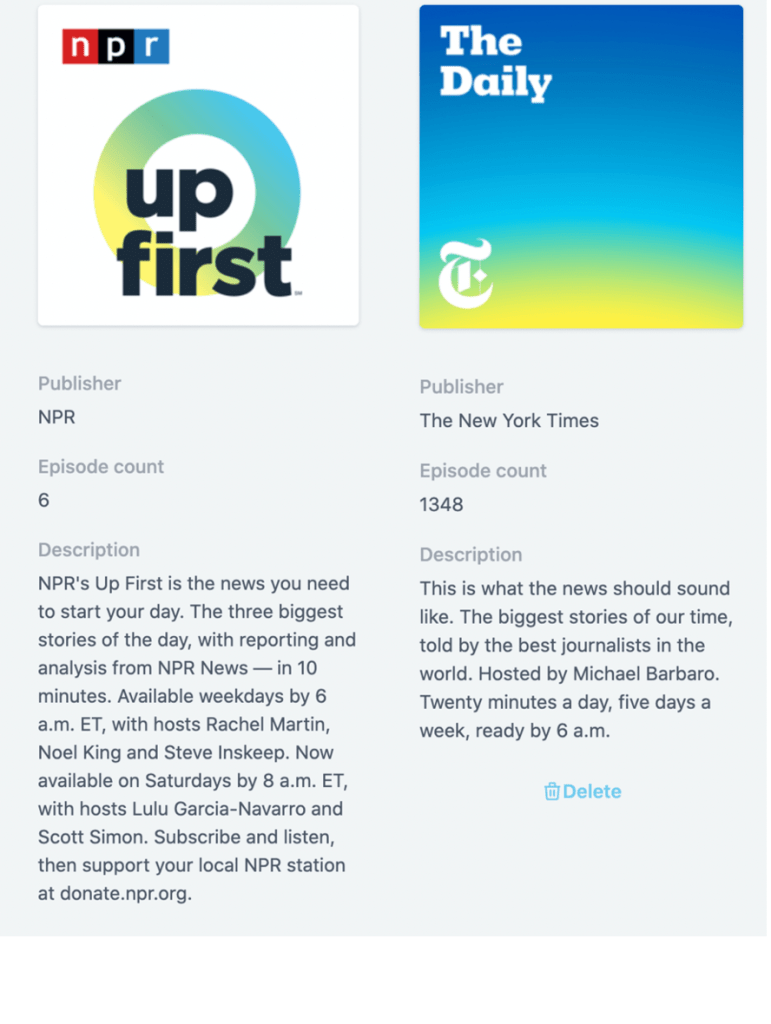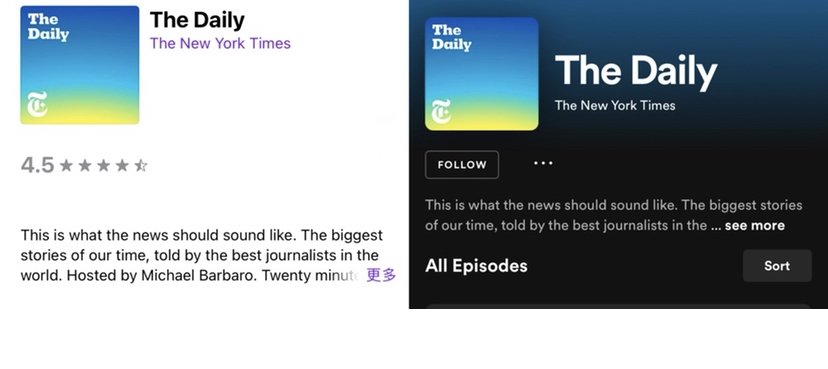Copywriting is a tough job: while easy to learn, it is hard to master. This article will explore some of the common mistakes when writing copies for your podcast from a Podcast Visibility Optimization (PVO) point of view.
What is copywriting for podcasts?
Copywriting refers to writing texts used on web pages, advertisements, marketing campaigns, etc. For podcasts, copywriting refers to writing engaging texts for your show description, episode names, and descriptions. Those elements are often referred to as metadata. That is the data that the listening platforms will use to index your content and decide on which search queries your show should be surfaced.
Why is copywriting important in optimizing the visibility of your podcast?
With more than 2 million shows out there, you need to do anything that could make your podcast stand out – great content, good marketing strategy, and appealing texts – to catch both the attention of the listeners and the search engines of Apple Podcasts or Spotify.
According to our Podcast Consumption and Discovery survey, 74% of the listeners have searched for content on the listening platforms (Apple Podcasts, Spotify, etc.), and 42% of them primarily discover content directly on those platforms. It means they search for podcasts organically and then decide which one to listen to based on what they perceive from the search results, including description, title, cover art, user ratings, etc.
So, which of those factors are the most important ones?
Out of 9 criteria that might affect their decisions to follow/subscribe, 13% of listeners care the most about show description, making it the most significant criterion. The episode title (12%) comes right after, before host/guest names, episode length, and user ratings.
So writing a good and crispy description of the show and the episodes is paramount in attracting new listeners. Along with podcast authority, it is the biggest lever to increase the visibility of your podcast.
If you are unsure what keywords to use in your description, read our guide on the subject and create your free Voxalyze account to do keyword research.
Copywriting mistakes to avoid for podcasts
Unfortunately, few podcasters know how to create fantastic descriptions and metadata. Below are six copywriting mistakes we often encountered when generating over 500 visibility reports and helping hundreds of podcast producers optimize their visibility through keyword tracking and exploration.
1. Barely writing a podcast description
Out of all the mistakes, this is the most common and fatal one. With Apple Podcasts, you can use up to 4000 characters (approximately 500 words) for your show description. Of course, you don’t have to take up all the space. However, it’s essential to make good use of the space offered to write a clear and enticing value proposition for your podcast.
A good copy will not only make listeners interested but will also help in improving your ranking on the search engine. If you barely write anything to present your podcast, the number of keywords your show will be ranking for will be lower.
2. Keyword stuffing your podcast description
Another common mistake consists in “stuffing” a podcast description with the same target term in hopes of ranking higher for that term in the search engines. Here is a fictitious example:
“This podcast is all about product marketing. As you know, product marketing is everything, and I love product marketing. In fact, good product marketing can change the fate of your company. We will talk in this show about how the right product marketing could help you be more successful.”
With a keyword-stuffed description, you run the risk of chasing the listener away. She may well think that the content of your show is similar to what he is reading and find it repelling. There is also the risk that the platform spots you playing and penalizes you. While extremely low, the risk does exist.
3. Not using the correct vocabulary for your audience
Before you create any content, you should be clear about who you’re talking to.
Different audiences require different tones and vocabularies. This is the reason people don’t use their Tinder profile picture on LinkedIn. The same applies to podcasts as the prospective audience expects a particular type of copy that uses the codes of the audience, be it technical terms, abbreviations,…etc.
4. Not focusing on your podcast niche
The description of your podcast and its episodes is like the window of a shop: it will draw either repel or attract visitors. By being too vague, you may end up attracting no one, just like that weird down-the-street shop selling shoes, cold drinks, and power tools.
According to our Podcast Consumption and Discovery survey, 54% of podcast listeners listen to 2-3 podcasts per week, 21% of them to 4-6. No one is expecting a single podcast to be their only source of information.
Imagine if you want to listen to a podcast to learn more about the French New Wave Movement. You would go to your listening app and type in “French cinema” in the search bar, and two results come up:
- Evolution of French Cinema: “A guide to French cinema evolution. From Auguste and Louis Lumière to New wave and May 68, and where it stands now.”
- French movies: “Everything about the French movie industry.”
The first copy gives more detailed information about its content. It’s clear and specific – it walks you through the evolution of French cinema, talks about the significant movements, and uses the correct vocabulary for film buffs. The second one is too broad and vague – does it speak about the French movie box office? French movie stars? Or do they recommend French movies?
In conclusion, when writing a description for your podcast, don’t try to do it all.
5. Overcomplicated writing
If you look at some of the major podcasts’ descriptions, they are usually relatively easy to read.

Good copywriting doesn’t necessarily mean using fancy and academic words that only people with high degrees could read. It might look sophisticated and professional, but low readability could diminish people’s willingness to read.
Browsing through podcasts is like skimming through resumes. Recruiters spend an average time of 7 seconds on each resume, according to HR Dive. Likewise, the listener will take a few seconds to check your podcast and decide whether or not to listen. The message should be clear, which means no complex metaphor or poem-like rhymes.
Copywriting is about marketing your product and increasing the conversion rate from “seen to start listening”, not about winning Pulitzer Prize.
6. Using transcripts as the description
Another common copywriting mistake. In the article “How to Promote your Podcast on a Budget“, we mentioned that you should repurpose your podcast into various forms, including transcripts.
Providing transcripts helps the audience better grasp what the episode is about. The transcripts could be posted on your website or blog but not used as episode descriptions. There are there’re several reasons why.
– Listening platforms are designed to listen, not read. The reading experience is often sub-optimal, especially on a mobile phone.
– Listeners expect to find the core content of the episodes in the description. Transcripts are long and are making it harder to grasp the information.
– If you provide the transcript, and some audience read the complete text or read through halfway and decide it’s not interesting, they might not listen or download. It could harm your growth.
If your show is sponsored or it takes a few minutes before getting right into the action, those moments will be at the top of the episode description. This is what potential listeners will read first and what the search engines will use to index your content.
Copywriting tips for podcasts
After listing some of the mistakes to avoid, here are a few tips to improve your podcast visibility.
1. Optimize the beginning of the podcast description
Our survey highlighted that 71% of listeners consume podcasts primarily on mobile phones. This implies limitations from the podcast listening platforms. Apple Podcasts displays the first three lines of texts; it’s about 150 characters or 20-40 words. Spotify shows the first two lines, about 120 characters or 20-30 words.

So you should really focus on those first few lines. Writing well-structured, valuable, clear, and precise texts within 30 words si really hard. Even professional advertisers struggle with this. Provide enough information and entice listeners to tap the “see more” button.
2. Write for humans first, for search engines second
Managing those two objectives is a balancing act. We recommend always writing for humans, coming up with a great description that will “convert”. The search engines have their own algorithms, and those get updated regularly. Optimizing purely for those doesn’t make much sense.
- Be clear and concise. Be prudent with every word you use and describe your show with well-structured texts.
- Avoid unnecessary repetition. Many podcasters like to repeat some information they deem of importance, such as host and guest names. That is not necessary.
- Nail your value proposition. Entice the users with the uniqueness and value of your show. Don’t use templates that hundreds of other podcasts are also using: stand out of the crowd.
- Research and pick the right keywords for your show. This is probably the most challenging part. On which keyword do you want your podcast to be discovered? What is the competition on those keywords? Do I have a chance to outrank those other podcasts? The good news is we have a step-by-step guide to help you choose the best keywords for your podcast.
3. Know your podcast audience
Learn your listeners like businesses learn their customers.
- Research in advance: before launching your podcast, do some research to identify your target audience. Select the right demographic for your show – age, gender, countries and regions, occupations, etc.
- Draw a listener persona. Persona is what businesses use to conceptualize their target customers. A persona includes all the details – annual income, career, hobbies, educational level, and even ideology. Once coming up with the ideal fictional listener, you can better understand the preferences of your audience.
4. Focus on your niche
Generic keywords usually have significant search volumes, but they also come with high difficulty and competition to rank for. A good approach for Podcast Visibility Optimization is to use long-tail keywords (e.g., guided meditation at home vs. meditation).
Those keywords are easier to rank high for and attract listeners highly interested in the niche. This will also increase your conversion rate from “seen the show description” to “started listening”.
5. Keep testing and iterating
Copywriting is a skill that requires practice. Podcast Visibility Optimization (PVO) as well. The chances that you will be hitting the nail on the head on the first attempt are slim, and it will probably take a few tentatives before having that perfect copy that describes your show well and optimizes its visibility. That is the price to pay to grow your audience.